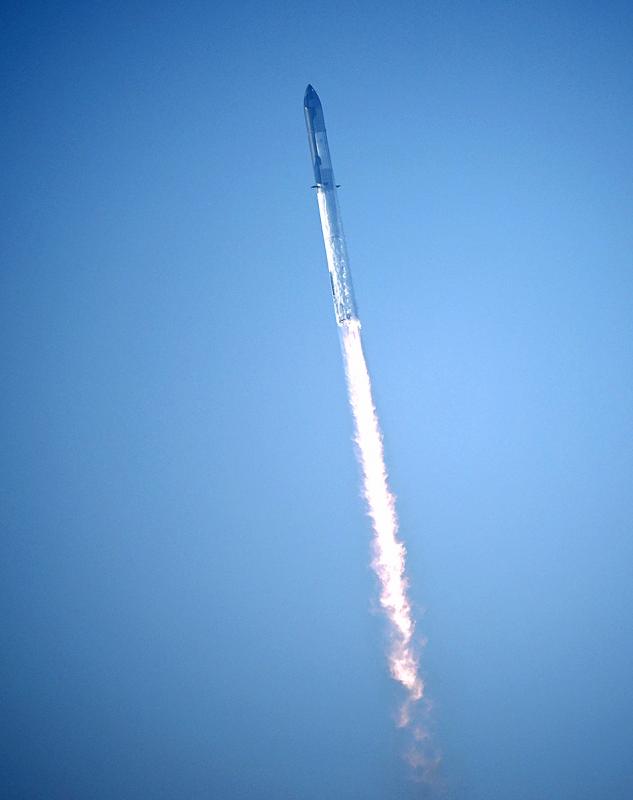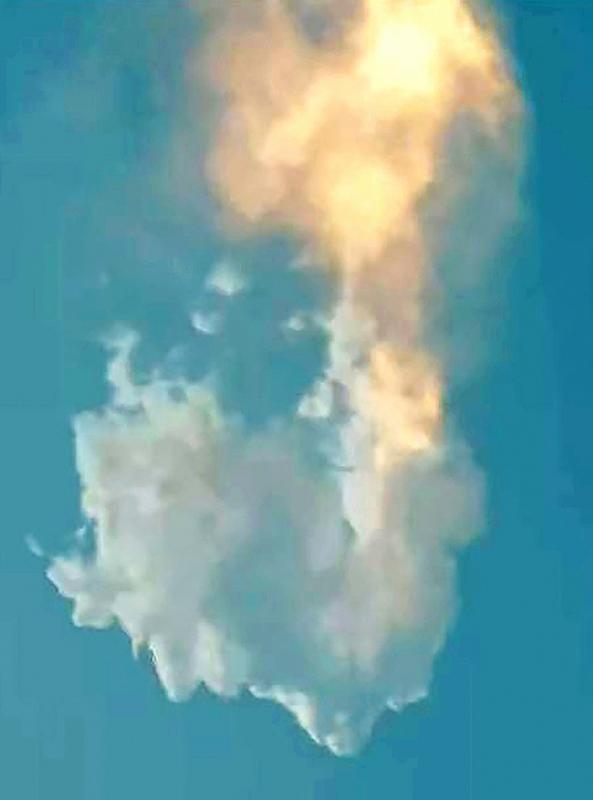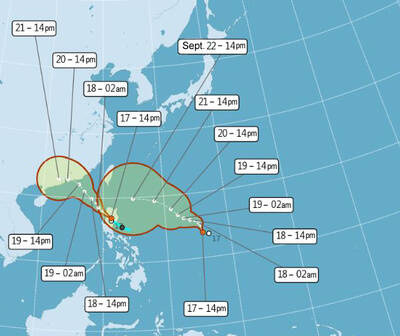Starship, the most powerful rocket ever built, exploded during its first flight yesterday, but SpaceX founder Elon Musk congratulated his team on an “exciting” test of the spacecraft designed to send astronauts to the Moon, Mars and beyond.
The uncrewed rocket disintegrated minutes after successfully blasting off at 8:33am from Starbase, the SpaceX spaceport in Boca Chica, Texas.
The Starship spacecraft that is to eventually carry crew and cargo had been scheduled to separate from the first-stage rocket booster three minutes into the flight, but separation failed to occur and the rocket blew up in a ball of fire over the Gulf of Mexico.

Photo: AFP
Despite the failure to complete the full 90-minute flight test and reach orbit, Musk declared it a success.
“Congrats SpaceX team on an exciting test launch of Starship!” Musk tweeted. “Learned a lot for next test launch in a few months.”
SpaceX said that “with a test like this, success comes from what we learn, and today’s test will help us improve Starship’s reliability as SpaceX seeks to make life multi-planetary.”

Photo: AFP/SPACEX
“We cleared the tower which was our only hope,” SpaceX quality systems engineer Kate Tice said.
NASA has picked the Starship spacecraft to ferry astronauts to the Moon in late 2025 — a mission known as Artemis III — for the first time since the Apollo program ended in 1972.
NASA chief Bill Nelson congratulated SpaceX, saying “every great achievement throughout history has demanded some level of calculated risk, because with great risk comes great reward.”
Starship consists of a 50m-tall spacecraft designed to carry crew and cargo that sits atop a 227m-tall first-stage Super Heavy booster rocket.
SpaceX conducted a successful test-firing of the 33 massive Raptor engines on the first-stage booster in February, but the Starship spacecraft and the Super Heavy rocket were being flown together for the first time.
The integrated test flight was intended to assess their performance in combination.
Musk had warned ahead of the test that technical issues were likely and sought to play down expectations for the inaugural flight.
“It’s the first launch of a very complicated, gigantic rocket. There’s a million ways this rocket could fail,” he said.
NASA is to take astronauts to lunar orbit itself in November next year using its own heavy rocket called the Space Launch System (SLS), which has been in development for more than a decade.
Starship is both bigger and more powerful than SLS and capable of lifting a payload of more than 100 tonnes into orbit.
It generates more than twice the thrust of the Saturn V rockets used to send Apollo astronauts to the Moon.
The plan for the integrated test flight was for the Super Heavy booster to separate from Starship after launch and splash down in the Gulf of Mexico.
They failed to separate however and the booster rocket and Starship spacecraft began spinning out of control, exploding four minutes into the test flight in what SpaceX euphemistically called a “rapid unscheduled disassembly.”
“If we get far enough away from the launchpad before something goes wrong then I think I would consider that to be a success,” Musk said prior to the test. “Just don’t blow up the launchpad.”
SpaceX foresees eventually putting a Starship into orbit, and then refueling it with another Starship so it can continue on a journey to Mars or beyond.

One of two tropical depressions that formed off Taiwan yesterday morning could turn into a moderate typhoon by the weekend, the Central Weather Administration (CWA) said yesterday. Tropical Depression No. 21 formed at 8am about 1,850km off the southeast coast, CWA forecaster Lee Meng-hsuan (李孟軒) said. The weather system is expected to move northwest as it builds momentum, possibly intensifying this weekend into a typhoon, which would be called Mitag, Lee said. The radius of the storm is expected to reach almost 200km, she said. It is forecast to approach the southeast of Taiwan on Monday next week and pass through the Bashi Channel

WARNING: People in coastal areas need to beware of heavy swells and strong winds, and those in mountainous areas should brace for heavy rain, the CWA said The Central Weather Administration (CWA) yesterday issued sea and land warnings for Typhoon Ragasa, forecasting that it would continue to intensify and affect the nation the most today and tomorrow. People in Hualien and Taitung counties, and mountainous areas in Yilan and Pingtung counties, should brace for damage caused by extremely heavy rain brought by the typhoon’s outer rim, as it was upgraded to a super typhoon yesterday morning, the CWA said. As of 5:30pm yesterday, the storm’s center was about 630km southeast of Oluanpi (鵝鑾鼻), Taiwan’s southernmost tip, moving northwest at 21kph, and its maximum wind speed had reached

The Central Weather Administration (CWA) yesterday said that it expected to issue a sea warning for Typhoon Ragasa this morning and a land warning at night as it approached Taiwan. Ragasa intensified from a tropical storm into a typhoon at 8am yesterday, the CWA said, adding that at 2pm, it was about 1,110km east-southeast of Oluanpi (鵝鑾鼻), Taiwan’s southernmost tip. The typhoon was moving northwest at 13kph, with sustained winds of up to 119kph and gusts reaching 155kph, the CWA Web site showed. Forecaster Liu Pei-teng (劉沛滕) said that Ragasa was projected to strengthen as it neared the Bashi Channel, with its 200km

PUBLIC ANNOUNCEMENTS: Hualien and Taitung counties declared today a typhoon day, while schools and offices in parts of Kaohsiung and Pingtung counties are also to close Typhoon Ragasa was forecast to hit its peak strength and come closest to Taiwan from yesterday afternoon through today, the Central Weather Administration (CWA) said. Taiwan proper could be out of the typhoon’s radius by midday and the sea warning might be lifted tonight, it added. CWA senior weather specialist Wu Wan-hua (伍婉華) said that Ragasa’s radius had reached the Hengchun Peninsula by 11am yesterday and was expected to hit Taitung County and Kaohsiung by yesterday evening. Ragasa was forecast to move to Taiwan’s southern offshore areas last night and to its southwestern offshore areas early today, she added. As of 8pm last night,